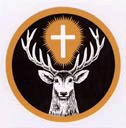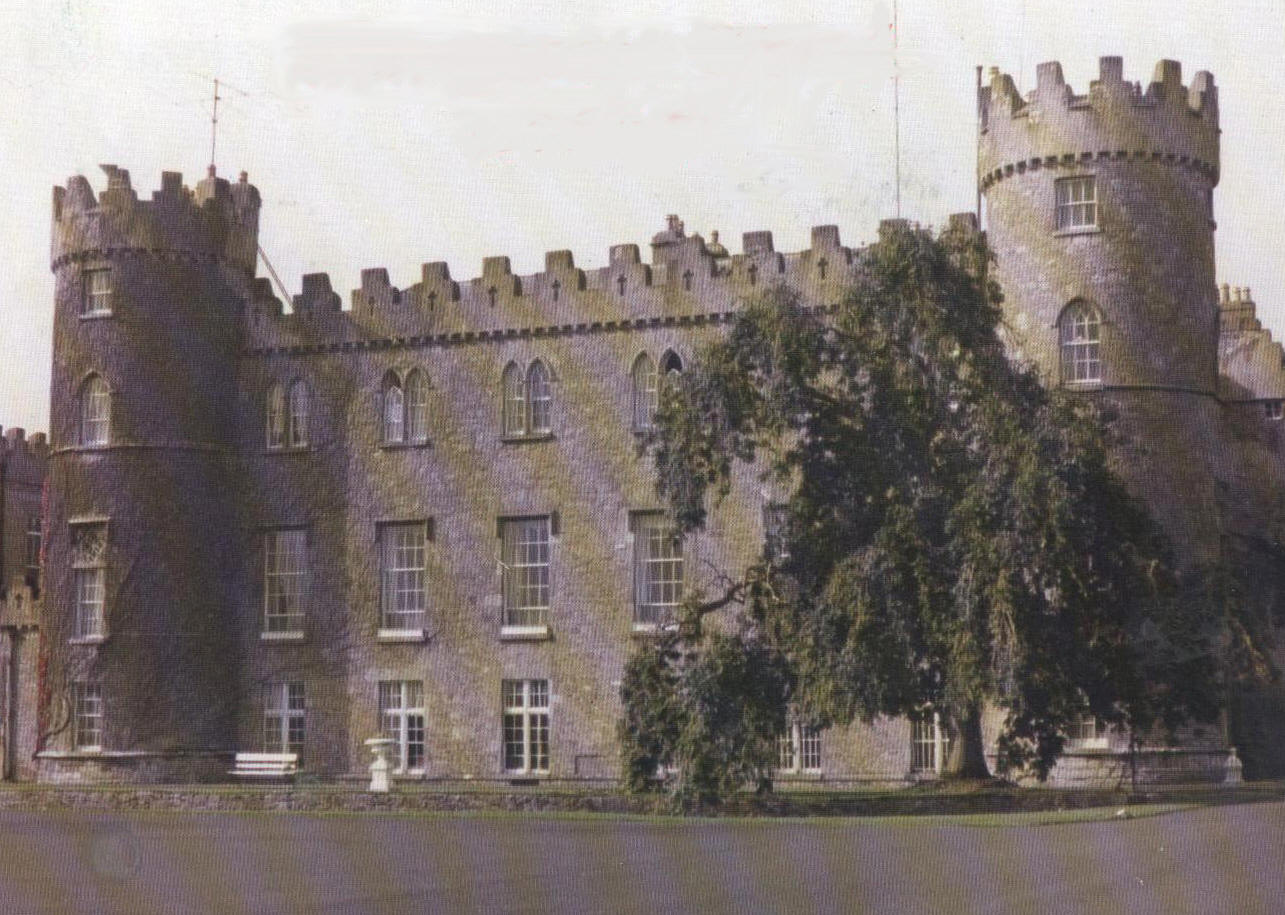|
Kildare/Carlow Families
The Eustace Family of Clongoweswood & Mainham, County Kildare By Reverend Matthew Devitt S.J. and other sources (Journal of the County Kildare Archaeological Society; Volume ?, pp. 207-215 (1901) ibid; pp395-398 (1955)
Clongoweswood (near Slane), County Kildare The name Clongowes Wood comes from the Latin/Irish hybrid; silva; the wood; cluain; the meadow; gobha; the smith. That is “the wood of the meadow of the smith”. The first mention of the name Clongowes Wood occurs in a Close Roll of King Henry IV, dated 24 February 1418, in which the dowerlands of Anastasia Wogan, the widow of Sir David Wogan of Rathcoffey, include the third part of the Silva de Clongowe, in the western part therein, that is to say forty acres. Just a century earlier on the reversion to the Crown of the Rathcoffey estate, first held by Adam de Hereford, a young friend of Strongbow who had come over to Ireland with him, Edward II in 1317 granted these lands to Sir John Wogan, then Lord Deputy in Ireland. The parish of Mainham, seven miles north of Naas, containing the townlands of Mount Armstrong, Moortown, Richardstown and Clongowes Wood, formed part of the Barony of Okethy, granted in 1317 to the ancient and powerful family of Wogan. Sir David Wogan, who died in about 1417, settled his estates upon his two sons Sir John and Sir Thomas, but when the elder produced no male heir a prolonged legal battle ensued. It was not until 1447 that an agreement was at last reached, under which the estates were divided in about equal shares between the two cousins, Anne, daughter of Sir John Wogan, and Nicholas, son of Sir Thomas Wogan.
In 1445 the disputed Wogan estates were placed in the custody of Sir Edward Eustace of Castlemartin, They had been much augmented that year by the death of Elizabeth (née Calfe), Baroness of Narragh, the widow of Sir John Staunton, Lord of Clane. Her only daughter, Anastacia, the widow of Sir David Wogan, thus became a great heiress. She had however a second husband, Sir John Bellew, who received part of her lands.) This junior branch of the Eustaces of Castlemartin settled at Mainham about 1450 and subsequently built the castle at Clongowes.
Anne Wogan, born in 1419, had meanwhile married Oliver Eustace, a younger son of the main Castlemartin branch, and her only child Edward had been born in 1445. (Oliver Eustace was probably the Oliver (see Vol. XI p. 276), a younger son of Sir Edward of Castlemartin. The Eustaces of Castlemartin and Clongowes Wood always remained closely affiliated.) Oliver had died soon afterwards, leaving Anne to fight for her inheritance, a fight that was by no means merely a legal matter, for in 1453, when taking refuge in Rathcoffey Castle (two miles N.E. of Mainham) with her little boy, during one of the violent disturbances of the period, she and her son Edward were robbed and carried off by Nicholas Wogan and his brothers.
In about 1455 Oliver’s widow, Anne had married again to Robert Dovedale (or Dowdall) the Chief Justice of Common Pleas. Under the settlement Anne Wogan Eustace received as part of her share the bulk of the parish of Mainham with Clongowes Wood Castle, one of the most important defences of the Pale, while Nicholas Wogan received Rathcoffey which remained in his family until 1642. The Eustaces also received a share of the Wogan estates further south, in Kilkea, Moone and Dunlost, with a few acres in Harristown and Carnalway. In 1493 Edward Eustace entailed Mainham Clongowes Wood and Danielstown to his heirs, and they held this important estate in direct line for nearly two centuries. The Eustace castle of Clongowes is mentioned in the State papers in 1538 in reference to the creation of Sir Thomas Eustace as Baron Kilcullen and Viscount Baltinglass. It was one of the links in the long chain of border strongholds guarding the Pale. The first definitive Pale was ordered to be built by Parliament in Drogheda, 1494, but earlier castles were built. Though nominally posted on the frontier line to repel the wild Irish and to prevent them from rustling the English cattle, William Eustace presumably Edward's son, held the estates in 1519 and married Margaret Fitzmaurice, with issue: ALEXANDER; Anne who married Nicholas Wogan of Rathcoffey and died 1537; and Eleanor who married John Talbot (dvp 1519), son of Robert Talbot of Belgard and his wife Margaret Eustace of Ballycotelan. Eleanor later married Richard Walsh. Alexander Eustace, William’s son, married Joan, daughter of Christopher Eustace of Kerdiffstown (High Sheriff 1465 and 1474-5). He died in 1557, leaving a son, WILLIAM and a daughter, Eleanor, who married Gerald FitzShaun FittzGerald of Donore. William Eustace his son, was High Sheriff in 1544, married Margaret FitzGerald of Allen and died in 1557, leaving a son, JAMES, and a daughter. Joan, who married Thomas Eustace of Kerdiffstown. (When appointed High Sheriff, William was described as William Eustace of Moone.) James Eustace married Ann Lien, and his daughter Alson married Walter Wesley, Baron of Narragh, and was buried with her husband at Moone. James died in 1576 a, was succeeded by his eldest son Maurice: Maurice Eustace apparently took no part in the Baltinglass rebellion. He was a Commissioner in 1583, High Sheriff in 1592 and a Juror in 1608. He married Joan, daughter of John Eustace of Castlemartin, and after her death in 1614 married secondly Elizabeth, daughter of Richard Ussher of Crumlin, Co. Dublin. He died in 1624, having had seven children. The children were William, his heir; Edward; James; Margaret m. Hubert Fox of Kilcoursey, King’s Co.; Elizabeth married James, natural son of (the 4th Earl of Kildare; Joan, married Walter Bermingham of Parsonstown; and a fourth daughter who seems to have married Pierce FitzGerald of Belan. Edward, the second son was the author of memorandum advocating the rehabilitation of the Irish then in the service of Spain, in order to influence opinion against Spain and the Jesuits. William Eustace, the eldest son, married Cicilie daughter of John Gaydon of Irishtown, and died before his father in 1621, having had seven sons and five daughters. They were: Richard and John who died young; James his heir; Nicholas, Vicar of Congowes Wood in 1641; Edward, Oliver and Walter of whom we know nothing; Elizabeth married Edward Tyrrell of Calverstown (died 1616); Eleanor, married Richard Walsh of Carrickniines and died 1613; Anne, married (?) Nicholas Wogan of Rathcoffey and Margaret and Ellis who probably died young. James Eustace, his eldest surviving son, married Mary Wogan. He, with his neighbour and brother-in-law Nicholas Wogan of Rathcoffy, took part in the rising of 1641 Their castles, well provisioned and fortified, interfered with Ormonde’s communications with Dublin, with the result that a Colonel Monk, later the famous Cromwellian general, was sent with artillery to capture them After one day’s resistance they were overpowered with a terrible slaughter of men, women and children. Some seventy prisoners, including priests, were taken to Dublin, court-martialed and executed. James Eustace fell in the fighting, but Nicholas Wogan escaped and was outlawed. Clongowes Wood Castle was blown up and the estates were of course confiscated. Part of Rathcoffy was restored to the Wogans at the Restoration, but not so the Eustace possessions, and thus practically ended this powerful branch of the family. Many of their members rest in the Castlemartin graveyard but in nameless graves. It would seem, however, that a Walter Eustace son of James and Mary (Wogan) must have escaped from the slaughter of 1641. He is believed to have married Mary Broderick and to have had two sons, Nicholas and Walter, a Dublin merchant. Nicholas married Dorothy Tiernan and had a son Oliver who Lived at Cadiz. The following Eustaces that lived in the eighteenth century are believed to have been descendants of the Mainham branch; James Eustace “of Mainham” who claimed in 1720 against the estate of Sir Maurice Eustace for a rent charge on certain land in Harristown. The Rev. John William Eustace a Dominican living in 1759, who had twice been Prior of the Convent of Naas. John Eustace of Mechlin, born in l734, and was the son of Bridget Gaydon. He went abroad before 1749 and served as a captain in Dillon’s Regiment of the Irish Brigade in the service of France. He died in 1777, and in 1882 his heirs were advertised for, but with what success is not known. After 1641 Clongowes Wood passed through several hands, but was finally purchased by the Jesuit Fathers who opened the present College in 1814. No Eustace memorials remain and the castle has disappeared, but well preserved lengths of the ancient rampart of the Pale still exist in the college grounds. The Eustaces of Clongoweswood remained undisturbed until the rebellion of 1641. In that year Nicholas Wogan, the head of the Rathcoffey family, became one of the Council of War of the Lords of the Pale who had allied themselves with Rory O'More. James Eustace mortgaged his property to Sir James Dixon and joined forces with Wogan, as did his friends and neighbours, Sir Andrew Aylmer of Donadea, Nicholas Sutton of Barberstown, John Gaydon of Irishtown (includes the present Straffan) and Garret Sutton of Richardstown. We know from a letter of the Lords Justices to Parliament in London that Lt. Colonel (afterwards General) Monck took both Clongowes and Rathcoffey in June 1642. He placed a garrison of 100 soldiers in Rathcoffey and made Clongowes uninhabitable. James Eustace continued to fight with the Confederates for another ten years but in 1652 he joined a French regiment. The Eustaces did not regain their estates after the Restoration. Under the Caroline Act of Settlement the Commissioners declared them to be ‘Irish papists, not innocent’. Charles II granted Clongowes to Sir Richard Reynell in 1667; within a short time Reynell sold the property, situated in about 1,000 acres, to Thomas Browne a Dublin barrister, for £2,100. Browne belonged to a Catholic family with considerable property situated in Back Lane, Church Street, Francis Street, Cork Street and Kilmainham. (Clongoweswood College informational brochure-first printed in 1981) and revised in 1987. These pages © Ronald Eustice, 2007
|

